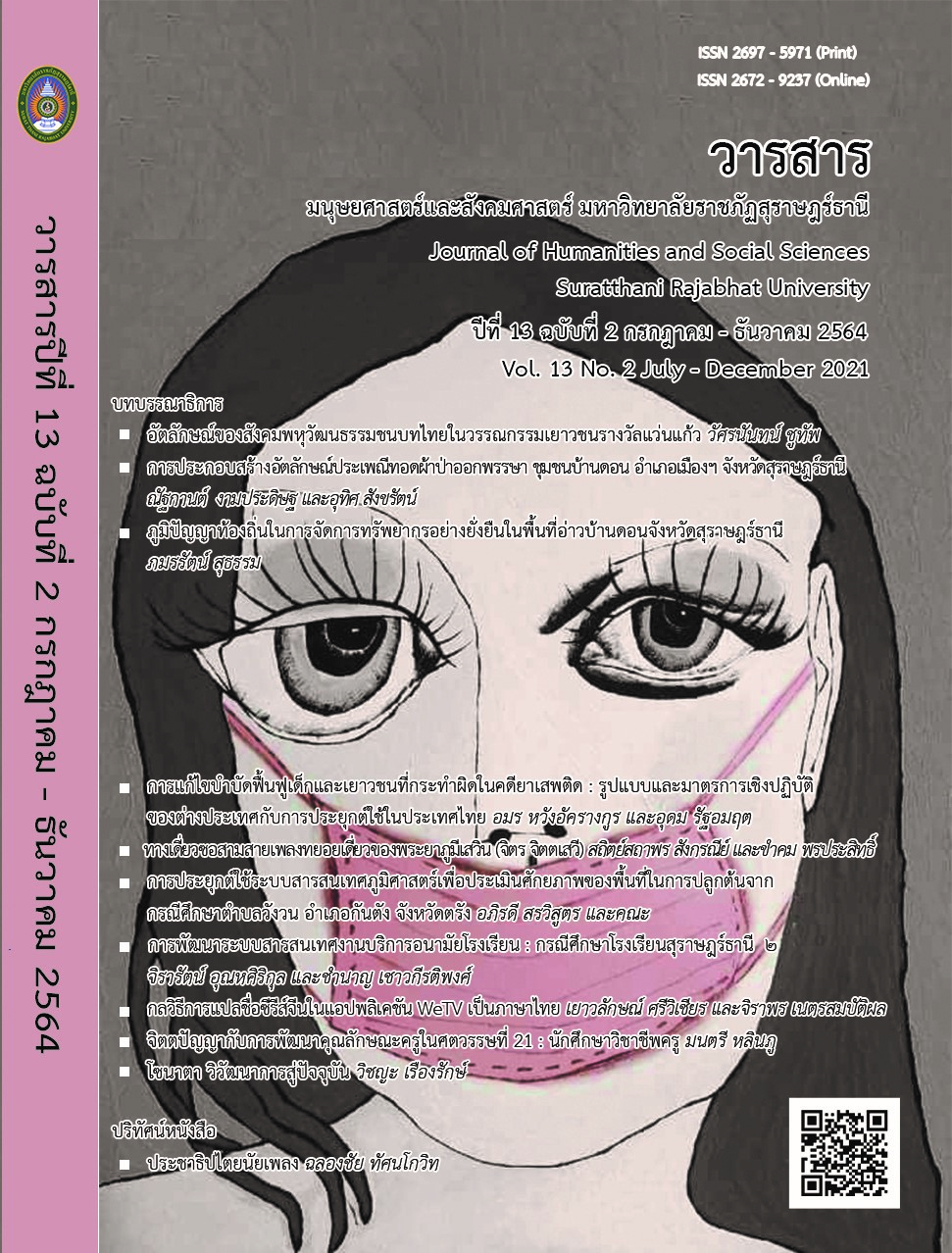อัตลักษณ์ของสังคมพหุวัฒนธรรมชนบทไทย ในวรรณกรรมเยาวชนรางวัลแว่นแก้ว
Main Article Content
บทคัดย่อ
การวิจัยครั้งนี้มีวัตถุประสงค์เพื่อ (1) วิเคราะห์คติชนวิทยาในวรรณกรรมเยาวชนรางวัลแว่นแก้วที่สะท้อนอัตลักษณ์ของชนบทไทยในภาคเหนือ ภาคใต้ ภาคตะวันออกเฉียงเหนือ และภาคกลาง (2) วิเคราะห์สังคมพหุวัฒนธรรมชนบทไทยในวรรณกรรมเยาวชนรางวัลแว่นแก้ว โดยศึกษาจากวรรณกรรมที่ได้รับรางวัลจากเวทีการประกวดรางวัลแว่นแก้ว จำนวน 11 เรื่อง ผลการวิจัย พบว่าคติชนวิทยาที่แสดงอัตลักษณ์ของภาคเหนือ ภาคใต้ ภาคตะวันออกเฉียงเหนือ และภาคกลาง นั้น ประกอบด้วย การตั้งถิ่นฐาน ประวัติศาสตร์ท้องถิ่น ปูชนียบุคคลประจำถิ่น สถาปัตยกรรมพื้นบ้าน ความเชื่อพื้นบ้าน ประเพณีพื้นบ้าน การแสดงพื้นบ้าน อาหารพื้นบ้าน เครื่องมือเครื่องใช้พื้นบ้าน สมุนไพรพื้นบ้าน นิทานพื้นบ้าน ตำนานพื้นบ้าน ลำนำ การทำคลอด การละเล่นของเด็ก การสาวไหมและการปั่นฝ้ายด้านสังคมพหุวัฒนธรรมชนบทไทยในวรรณกรรมเยาวชนรางวัลแว่นแก้วนักเขียนได้นำเสนอประเด็นต่าง ๆ ดังนี้ (1) นักเขียนภาคตะวันออกเฉียงเหนือ นำเสนอภาพวัฒนธรรมของ “ส่วย” ผ่านหมู่บ้านผับแล้ง ที่โดนเหยียดหยามทางวัฒนธรรม (2) นักเขียนภาคเหนือนำเสนอภาพชนกลุ่มน้อยเผ่าปาเกอะญอที่สังคมรอบนอกมองเขาเป็นเพียงแค่ “ผู้ใช้แรงงานราคาต่ำ” (3) นักเขียนภาคใต้นำเสนอภาพความแปลกแยกของคนชนบทในสังคมเมือง (4) นักเขียนภาคกลางนำเสนอภาพวัฒนธรรมของคนจีนบนแผ่นดินไทย ที่ทั้งสองวัฒนธรรมสามารถผสมผสานเข้ากันอย่างลงตัว จะเห็นว่าภาพที่นำเสนอผ่านวรรณกรรมเยาวชนรางวัลแว่นแก้วนั้นสะท้อนชีวิตของชาวบ้านได้อย่างเข้มข้น
Article Details

อนุญาตภายใต้เงื่อนไข Creative Commons Attribution-NonCommercial-NoDerivatives 4.0 International License.
ต้นฉบับทุกเรื่องที่พิมพ์เผยแพร่ได้รับการตรวจสอบความถูกต้องทางวิชาการโดยผู้ทรงคุณวุฒิ (Peer Peview) เฉพาะสาขามนุษยศาสตร์และสังคมศาสตร์ การตีพิมพ์บทความซ้ำต้องได้รับการอนุญาตจากกองบรรณาธิการเป็นลายลักษณ์อักษร
เอกสารอ้างอิง
จรรยา ชูสุวรรณ. (2553). บ้านชายทุ่ง (พิมพ์ครั้งที่ 3). กรุงเทพฯ: นานมีบุ๊คส์พับลิ
เคชั่นส์.
จันทรา รัศมีทอง. (2553). บ้านไม้ชายคลอง. กรุงเทพฯ: นานมีบุ๊คส์พับลิเคชั่นส์.
ทวี ชูโรจน์. (2558). บ้านทุ่งเมืองลุง. กรุงเทพฯ: นานมีบุ๊คส์พับลิเคชั่นส์.
นุกูล ตันริยงค์. (2553). ชีวิตศิษย์วัด. กรุงเทพฯ: นานมีบุ๊คส์พับลิเคชั่นส์.
ปัญจมา. (2559). วันวารของแม่ (พิมพ์ครั้งที่ 9). กรุงเทพฯ: นานมีบุ๊คส์พับลิเคชั่นส์.
ปัทมา กลิ่นทอง. (2557). เกิดเป็นเด็กตลาด (พิมพ์ครั้งที่ 2). กรุงเทพฯ: นานมีบุ๊คส์พับลิ
เคชั่นส์.
ยายนาง. (2560). เมื่อยายอายุเท่าหนู (พิมพ์ครั้งที่ 6). กรุงเทพฯ: นานมีบุ๊คส์พับลิเคชั่นส์.
ศรัณย์ภัทร์ บุญฮก. (2558). คติชนในนวนิยายของพงศกร. วิทยานิพนธ์อักษรศาสตรมหา
บัณฑิต สาขาวิชาภาษาไทย. กรุงเทพฯ: จุฬาลงกรณ์มหาวิทยาลัย.
ศรัทธา ลาภวัฒนเจริญ. (2553). รายงานปิดเทอมของนักสารคดีตัวจิ๋ว ตอน ตลุยแดน
ล้านนา (พิมพ์ครั้งที่ 3). กรุงเทพฯ: นานมีบุ๊คส์พับลิเคชั่นส์.
สว่าง คงยก. (2554). บ้านเรา (พิมพ์ครั้งที่ 8). กรุงเทพฯ: นานมีบุ๊คส์พับลิเคชั่นส์.
สิริวธู วงศโภชย์. (2555). จากยายอีสานถึงหลานฝรั่ง. กรุงเทพฯ: นานมีบุ๊คส์พับลิเคชั่นส์.
สุกัญญา สุจฉายา. (2556). วรรณกรรมมุขปาฐะ. กรุงเทพฯ: โครงการเผยแพร่ผลงานทาง
วิชาการ คณะอักษรศาสตร์ จุฬาลงกรณ์มหาวิทยาลัย.
อุดร วงษ์ทับทิม. (2553). เจ๊าะเกอโด่เด็กบ้านดอย (พิมพ์ครั้งที่ 4). กรุงเทพฯ: นานมีบุ๊คส์
พับลิเคชั่นส์.


